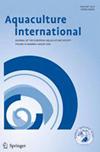Impact of long-term seaweed (Kappaphycus alvarezii) aquaculture on species and functional diversity of macrobenthic communities in Southeastern coast, India
Abstract
The commercial cultivation of Kappaphycus alvarezii in the southeastern part of India has become one of the fastest-growing aquaculture industries. As an ecosystem engineer, K. alvarezii exerts significant control over benthic resource availability and habitat modification by means of changing sedimentation patterns and availability of resources which might enrich the benthic assemblages. However, the impact of long-term seaweed cultivation on habitat modification and benthic ecosystem functionality has not been well documented. The present study made an attempt to investigate how the species and functional diversity of macrobenthic assemblages differ in cultivation sites as compared to non-cultivated areas along the same coastline. Results showed a significant increase in abundance, biomass, and cumulative species diversity of macroinvertebrates in the cultivation sites which is strongly correlated with K. alvarezii-mediated organic enrichment and finer particle trapping in the benthic strata. Furthermore, a biological trait analysis coupled with functional diversity indices characterizes the cultivation plots with diversified ecological groups and a lower degree of functional overlap. Interestingly, due to the strong coupling between species and functional diversity indices, cultivation sites were having a low functional redundancy. This lower redundancy implies that functional characters might rapidly get lost from this system if species diversity declines. Therefore, the present investigation gives a powerful insight to the ecosystem health status of the long-term seaweed cultivation sites where systematic monitoring and health assessment studies on a regular basis are highly recommended.

 求助内容:
求助内容: 应助结果提醒方式:
应助结果提醒方式:


